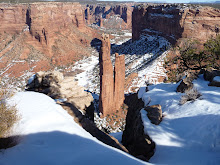Aside from a quick walk with my neighbor and her dog and another win for the Jazz, not much exciting going on around here. So I'll continue with some tidbits I learned at Hubbell Trading Post.
I mentioned watching Ruby, the rug-weaving demonstrator, at her loom for part of Friday, and the visitor loom that I tried out. A little more about that may be interesting. I've posted a picture of the NPS herd of Churro sheep to show where the wool comes from. These sheep were brought back to a pure or nearly-pure breed with effort by locating the descendants of the ones given to the Long Walk survivors upon their release to return to their ancestral lands. Many had been interbred with other breeds, but a few pockets of pure-bred Churros existed in the back country. The original name was Churra, but that was bastardized to Churro by white ranchers at some point.
Churro is a Spanish breed, valued for the long, strong fibers in their wool that can be spun into a very fine but extra strong yarn. The yarn that Ruby was using was commercially spun and dyed, but I was surprised that the loft was about the thickness of baby yarn or fingering yarn (for the crafters' info). This is very fine, or thin, and it takes rows and rows to create an inch of rug.
Ruby had just begun what the interp told me was considered an average-size rug, I'd say 4 ft. by 6 ft. or thereabouts. He told me it would take about 3 months to complete if Ruby worked 40 hours a week on it. More if she used a more complex pattern. During much of Friday, she was bent over a notebook drawing and erasing patterns, saying she couldn't decide what to do with it. I've seen a poster that indicated there are several patterns that originated and are distinctive of certain regions. There is a Chinle pattern, for example, and one called Ganado Red. Also Two Grey Hills, which originates between Ganado and Ft. Defiance, and many others. Ruby told me that in the old days, women didn't draw out their patterns, they just knew what to do. This goes along with what a sidewalk vendor had told us about Spider Woman, who taught the Dineh how to weave and gave them patterns.
The rug on the visitor's loom was much smaller, and nearly finished. Weaving it had become very difficult, because the tool, called a batten, that separated the alternate warp (vertical) threads from front to back, was too large for the remaining length of those threads. The result was that as I was weaving, the batten would suddenly flip 90 degrees and the threads wouldn't be separated far enough to get the weft thread (the horizontal yarn) through.
The loom itself, though made of crude materials, was a masterpiece of engineering. I looked at the chart of all the parts, comparing closely to the real object, then tried to follow the step-by-step example, and was completely defeated. The interp had to come and show me. There is a horizontal piece attached by what look like slipknots to every other warp thread and used to pull some forward when the weft goes in one direction and let them slip to the back for the alternating row. Each time, the batten is slipped through the resulting gap and turned to increase the gap, and it allows the weaver to simply pull the weft through, rather than weaving back and forth. The batten is almost as long as the rug is wide, carved from wood and polished by years of use. It is perhaps 3/8 of an inch thick, about an inch wide, and the ends are tapered and rounded. Ruby later told me that it was too big for the end of the rug, and that a smaller one was needed--one maybe a half-inch wide wouldn't have flipped on me like this one did, from the tension in the warp threads. Someone had made a 'needle' out of what looked like coat-hanger wire, to help with pulling the weft through, but I was told it wasn't traditional, so of course I couldn't use it.
One of the several very important things to do was to not pull too hard on the weft yarn, which results in a rug shape like this: ) ( Of course, with various visitors including children weaving a few rows each, this rug looked like that already. Another thing to do is use a fork-like comb to pack the weft down hard enough for it to obscure the warp threads, so you don't have white string-like vertical stripes. I re-wove my two or three rows several times before I was satisfied with the result. Ruby made it look very fluid and never took out a row. By the end of three rows, my back was aching across the shoulder blades as if I had been actually rowing a canoe.
The last thing I learned about Navajo rug-making is that the patterns aren't necessarily worked row by row. Each color change requires a new piece of yarn, no matter how small, and that entire part of the pattern is worked independently of the rest of the horizontal rows. That's how the front and back look virtually the same, with no dangling yarn or joinings. In a book that I looked through while there, I saw a photograph of how the reproduction rugs for the Hubbell home had been made, with the original hung behind the loom, and the weaver simply matching the pattern like you would trace a picture with a lightbox. More about those reproductions another time.

No comments:
Post a Comment